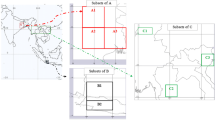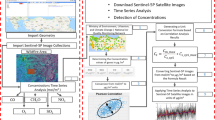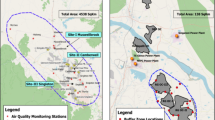Abstract
In situ coal fires significantly pollute the environment in many countries of the world. Monitoring these pollutants is challenging due to extensive area coverage and spatial variations. Thus, the present study demonstrates the method of deriving the spatial and temporal profiles of columnar density of three major greenhouse gases (carbon monoxide (CO), sulfur dioxide (SO2), and nitrogen dioxide (NO2)) in an in situ coal fire region (Jharia coalfield (JCF), India) using high-resolution satellite data (TROPOMI) of the European Space Agency (ESA). The study also demonstrates a new methodology for estimating greenhouse gas emissions from in situ coal burning. JCF is one of the significant polluted mining regions with multiple in situ coal fire pockets. The columnar density of the gaseous pollutants in the mining region was compared with the same in the rural, urban, and forest regions to identify the major emission inventories. The study results indicated that coal fire is the major source of CO emission in the region, as the CO was high in the fire regions compared to that of the non-fire regions. But, the major source of NO2 is the traffic, as the NO2 was high in the city area as compared to other regions. The spatial profile of SO2 does not reveal the specific emission sources. The study results indicated that TROPOMI onboard satellite sensors could be effectively used for deriving the spatial profiles of greenhouse gaseous in coal fire regions, which further assist in identifying the emission inventories. Furthermore, the satellite-based Earth observations offer information to understand and manage the greenhouse gas emissions over a large area.












Similar content being viewed by others
Availability of data and materials
The datasets analyzed during the current study are available on the Google Earth Engine platform. All data generated during this study are included in this published article.
References
Astrup, T., Møller, J., & Fruergaard, T. (2009). Incineration and co-combustion of waste: Accounting of greenhouse gases and global warming contributions. Waste Management and Research, 27(8), 789–799. https://doi.org/10.1177/0734242X09343774
Barnes, W. L., Pagano, T. S., & Salomonson, V. V. (1998). Prelaunch characteristics of the moderate resolution imaging spectroradiometer (MODIS) on EOS-AMI. IEEE Transactions on Geoscience and Remote Sensing, 36(4), 1088–1100. https://doi.org/10.1109/36.700993
Beer, R., Glavich, T. A., & Rider, D. M. (2001). Tropospheric emission spectrometer for the Earth Observing System’s Aura satellite. Applied Optics, 40(15), 2356. https://doi.org/10.1364/ao.40.002356
Biswal, S. S., & Gorai, A. K. (2020). Change detection analysis in coverage area of coal fire from 2009 to 2019 in Jharia Coalfield using remote sensing data. International Journal of Remote Sensing, 41(24), 9545–9564. https://doi.org/10.1080/01431161.2020.1800128
Biswal, S. S., & Gorai, A. K. (2021). Studying the coal fire dynamics in Jharia coalfield, India using time-series analysis of satellite data. Remote Sensing Applications: Society and Environment, 23, 100591. https://doi.org/10.1016/j.rsase.2021.100591
Borrell, P., Burrows, J. P., Richter, A., Platt, U., & Wagner, T. (2003). New directions: New developments in satellite capabilities for probing the chemistry of the troposphere. Atmospheric Environment, 37(18), 2567–2570. https://doi.org/10.1016/S1352-2310(03)00150-X
Bovensmann, H., Burrows, J. P., Buchwitz, M., Frerick, J., Noël, S., Rozanov, V. V., et al. (1999). SCIAMACHY: Mission objectives and measurement modes. Journal of the Atmospheric Sciences, 56(2), 127–150. https://doi.org/10.1175/1520-0469(1999)056%3c0127:SMOAMM%3e2.0.CO;2
Braadbaart, F., Poole, I., Huisman, H. D. J., & van Os, B. (2012). Fuel, Fire and Heat: An experimental approach to highlight the potential of studying ash and char remains from archaeological contexts. Journal of Archaeological Science, 39(4), 836–847. https://doi.org/10.1016/j.jas.2011.10.009
Bréon, F. M., & Ciais, P. (2010). Spaceborne remote sensing of greenhouse gas concentrations. Comptes Rendus - Geoscience, 342(4–5), 412–424. https://doi.org/10.1016/j.crte.2009.09.012
Burrows, J. P., Buchwitz, M., Rozanov, V., Weber, M., Richter, A., Ladstätter-Weißenmayer, A., & Eisinger, M. (1997). The Global Ozone Monitoring Experiment (GOME): Mission, instrument concept, and first scientific results. European Space Agency, (Special Publication) ESA SP, 56(414 PART 2), 585–590.
Callies, J., Corpaccioli, E., Eisinger, M., Hahne, A., & Lefebvre, A. (2000). GOME-2-Metop’s second-generation sensor for operational ozone monitoring. ESA bulletin, 102, 28–36.
Chevallier, F., Bréon, F. M., & Rayner, P. J. (2007). Contribution of the Orbiting Carbon Observatory to the estimation of CO2 sources and sinks: Theoretical study in a variational data assimilation framework. Journal of Geophysical Research Atmospheres, 112(9). https://doi.org/10.1029/2006JD007375
Clerbaux, C., Boynard, A., Clarisse, L., George, M., Hadji-Lazaro, J., Herbin, H., et al. (2009). Monitoring of atmospheric composition using the thermal infrared IASI/MetOp sounder. Atmospheric Chemistry and Physics, 9(16), 6041–6054. https://doi.org/10.5194/acp-9-6041-2009
Crow, D. J. G., Balcombe, P., Brandon, N., & Hawkes, A. D. (2019). Assessing the impact of future greenhouse gas emissions from natural gas production. Science of the Total Environment, 668, 1242–1258. https://doi.org/10.1016/j.scitotenv.2019.03.048
Diner, D. J., Beckert, J. C., Reilly, T. H., Bruegge, C. J., Conel, J. E., Kahn, R. A., et al. (1998). Multi-angle imaging spectroradiometer (MISR) instrument description and experiment overview. IEEE Transactions on Geoscience and Remote Sensing, 36(4), 1072–1087. https://doi.org/10.1109/36.700992
Ding, A. J., Fu, C. B., Yang, X. Q., Sun, J. N., Petäjä, T., Kerminen, V. M., et al. (2013). Intense atmospheric pollution modifies weather: A case of mixed biomass burning with fossil fuel combustion pollution in eastern China. Atmospheric Chemistry and Physics, 13(20), 10545–10554. https://doi.org/10.5194/acp-13-10545-2013
Drummond, J. R., Bailak, G. V., & Mand, G. (1995). The Measurements of Pollution in the Troposphere (MOPITT) Instrument. In Applications of Photonic Technology (pp. 197–200). https://doi.org/10.1007/978-1-4757-9247-8_38
Gielisch, H., & Kropp, C. (2018). Coal fires a major source of greenhouse gases- a forgotten problem. Environmental Risk Assessment and Remediation, 02(01). https://doi.org/10.4066/2529-8046.100030
Gurney, K. R., Mendoza, D. L., Zhou, Y., Fischer, M. L., Miller, C. C., Geethakumar, S., & Du Can, S. D. L. R. (2009). High-resolution fossil fuel combustion CO2 emission fluxes for the United States. Environmental Science and Technology, 43(14), 5535–5541. https://doi.org/10.1021/es900806c
Hamazaki, T., Kaneko, Y., Kuze, A., & Kondo, K. (2005). Fourier transform spectrometer for Greenhouse Gases Observing Satellite (GOSAT). In Enabling Sensor and Platform Technologies for Spaceborne Remote Sensing (Vol. 5659, p. 73). https://doi.org/10.1117/12.581198
Hamilton, M., McLachlan, R. S., & Burneo, J. G. (2009). Can I go out for a smoke? A nursing challenge in the epilepsy monitoring unit. Seizure, 18(4), 285–287. https://doi.org/10.1016/j.seizure.2008.11.002
Heede, R. (2014). Tracing anthropogenic carbon dioxide and methane emissions to fossil fuel and cement producers, 1854–2010. Climatic Change, 122(1–2), 229–241. https://doi.org/10.1007/s10584-013-0986-y
Herndon, J. M. (2018). Air pollution, not greenhouse gases: The principal cause of global warming. Journal of Geography, Environment and Earth Science International, 17(2), 1–8. https://doi.org/10.9734/jgeesi/2018/44290
Hoff, R. M., & Christopher, S. A. (2009). Remote sensing of particulate pollution from space: Have we reached the promised land? Journal of the Air and Waste Management Association, 59(6), 645–675. https://doi.org/10.3155/1047-3289.59.6.645
Howarth, R. W. (2014). A bridge to nowhere: Methane emissions and the greenhouse gas footprint of natural gas. Energy Science and Engineering, 2(2), 47–60. https://doi.org/10.1002/ese3.35
Jaeglé, L., Steinberger, L., Martin, R. V., & Chance, K. (2005). Global partitioning of NOx sources using satellite observations: Relative roles of fossil fuel combustion, biomass burning and soil emissions. Faraday Discussions, 130, 407–423. https://doi.org/10.1039/b502128f
Karavalakis, G., Hajbabaei, M., Jiang, Y., Yang, J., Johnson, K. C., Cocker, D. R., & Durbin, T. D. (2016). Regulated, greenhouse gas, and particulate emissions from lean-burn and stoichiometric natural gas heavy-duty vehicles on different fuel compositions. Fuel, 175, 146–156. https://doi.org/10.1016/j.fuel.2016.02.034
Kuze, A., Kondo, K., Hamazaki, T., Oguma, H., Morino, I., Yokota, T., & Inoue, G. (2006). Greenhouse gases monitoring from the GOSAT satellite. Journal of the Remote Sensing Society of Japan, 26(1), 41–42. https://doi.org/10.11440/rssj1981.26.41
Kweku, D., Bismark, O., Maxwell, A., Desmond, K., Danso, K., Oti-Mensah, E., et al. (2018). Greenhouse effect: Greenhouse gases and their impact on global warming. Journal of Scientific Research and Reports, 17(6), 1–9. https://doi.org/10.9734/jsrr/2017/39630
Lambrigtsen, B., Fetzer, E., Fishbein, E. Lee, S. Y., Pagano, T. (2004). AIRS - The atmospheric infrared sounder International Geoscience and Remote Sensing Symposium (IGARSS) 2204–2207 https://doi.org/10.1364/opn.2.10.000025
Lamsal, L. N., Martin, R. V., Padmanabhan, A., Van Donkelaar, A., Zhang, Q., Sioris, C. E., et al. (2011). Application of satellite observations for timely updates to global anthropogenic NOx emission inventories. Geophysical Research Letters, 38(5). https://doi.org/10.1029/2010GL046476
Landry, J. S., & Matthews, H. D. (2016). Non-deforestation fire vs. fossil fuel combustion: The source of CO2 emissions affects the global carbon cycle and climate responses. Biogeosciences, 13(7), 2137–2149. https://doi.org/10.5194/bg-13-2137-2016
Lashof, D. A., & Ahuja, D. R. (1990). Relative contributions of greenhouse gas emissions to global warming. Nature, 344(6266), 529–531. https://doi.org/10.1038/344529a0
Levelt, P. F., Van Den Oord, G. H. J., Dobber, M. R., Mälkki, A., Visser, H., de Vries, J., Stammes, P., Lundell, J. O. V., & Saari, H. (2006). The Ozone Monitoring Instrument. IEEE Transactions on Geoscience and Remote Sensing, 44(5), 1093–1101. https://doi.org/10.1109/TGRS.2006.872333
Liu, R., Men, C., Liu, Y., Yu, W., Xu, F., & Shen, Z. (2016). Spatial distribution and pollution evaluation of heavy metals in Yangtze estuary sediment. Marine Pollution Bulletin, 110(1), 564–571. https://doi.org/10.1016/j.marpolbul.2016.05.060
Martin, R. V. (2008). Satellite remote sensing of surface air quality. Atmospheric Environment, 42(34), 7823–7843. https://doi.org/10.1016/j.atmosenv.2008.07.018
Mehta, D. R. S., Narayana Murthy, B. R., & Fox, C. S. (1957). A revision of the geology and coal resources of the Jharia coalfield. Manager of Publications.
Mengpin, G., & Johannes, F. (2020). 4 Charts Explain Greenhouse Gas Emissions by Countries and Sectors. World Resources Institute. https://www.wri.org/blog/2020/02/greenhouse-gas-emissions-by-country-sector. Accessed 8 February 2021
Mineral Exploration Corporation limited. (2013). Geological report on coal exploration production support drilling (Vol. 1).
Miyazaki, K., Eskes, H., Sudo, K., Folkert Boersma, K., Bowman, K., & Kanaya, Y. (2017). Decadal changes in global surface NOx emissions from multi-constituent satellite data assimilation. Atmospheric Chemistry and Physics, 17(2), 807–837. https://doi.org/10.5194/acp-17-807-2017
Mohalik, N. K., Lester, E., Lowndes, I. S., & Singh, V. K. (2016). Estimation of greenhouse gas emissions from spontaneous combustion/fire of coal in opencast mines–Indian context. Carbon Management, 7(5–6), 317–332. https://doi.org/10.1080/17583004.2016.1249216
Munawer, M. E. (2018). Human health and environmental impacts of coal combustion and post-combustion wastes. Journal of Sustainable Mining, 17(2), 87–96. https://doi.org/10.1016/j.jsm.2017.12.007
Ozdeniz, H., Sivrikaya, O., Sensogut, C. (2014). Mine planning and equipment selection Mine Planning and Equipment Selection 637–644. https://doi.org/10.1007/978-3-319-02678-7
Palmer, P. I. (2008). Quantifying sources and sinks of trace gases using spaceborne measurements: Current and future science. Philosophical Transactions of the Royal Society A: Mathematical, Physical and Engineering Sciences, 366(1885), 4509–4528. https://doi.org/10.1098/rsta.2008.0176
Richter, A., Burrows, J. P., Nüß, H., Granier, C., & Niemeier, U. (2005). Increase in tropospheric nitrogen dioxide over China observed from space. Nature, 437(7055), 129–132. https://doi.org/10.1038/nature04092
Schoeberl, M. R., Douglass, A. R., Hilsenrath, E., Bhartia, P. K., Beer, R., Waters, J. W., et al. (2006). Overview of the EOS aura mission. IEEE Transactions on Geoscience and Remote Sensing, 44(5), 1066–1072. https://doi.org/10.1109/TGRS.2005.861950
Theys, N., De Smedt, I., Yu, H., Danckaert, T., Van Gent, J., Hörmann, C., et al. (2017). Sulfur dioxide retrievals from TROPOMI onboard Sentinel-5 Precursor: Algorithm theoretical basis. Atmospheric Measurement Techniques, 10(1), 119–153. https://doi.org/10.5194/amt-10-119-2017
Thompson, W., Whistance, J., & Meyer, S. (2011). Effects of US biofuel policies on US and world petroleum product markets with consequences for greenhouse gas emissions. Energy Policy, 39(9), 5509–5518. https://doi.org/10.1016/j.enpol.2011.05.011
UCS. (2008). Coal and Air Pollution. Union of Concerned Scientists. https://www.ucsusa.org/resources/coal-and-air-pollution. Accessed 14 December 2020
van Geffen, J. H. G. M., Eskes, H. J., Boersma, K. F., Maasakkers, J. D., & Veefkind, J. P. (2019). TROPOMI ATBD of the total and tropospheric NO2 data products. S5p/TROPOMI, (1.4.0), 1–76. https://sentinel.esa.int/documents/247904/2476257/Sentinel-5P-TROPOMI-ATBD-NO2-data-products
Veefkind, J. P., Aben, I., McMullan, K., Förster, H., de Vries, J., Otter, G., et al. (2012). TROPOMI on the ESA Sentinel-5 Precursor: A GMES mission for global observations of the atmospheric composition for climate, air quality and ozone layer applications. Remote Sensing of Environment, 120, 70–83. https://doi.org/10.1016/j.rse.2011.09.027
Venkatesh, A., Jaramillo, P., Griffin, W. M., & Matthews, H. S. (2011). Uncertainty analysis of life cycle greenhouse gas emissions from petroleum-based fuels and impacts on low carbon fuel policies. Environmental Science and Technology, 45(1), 125–131. https://doi.org/10.1021/es102498a
Vidot, J., Landgraf, J., Hasekamp, O. P., Butz, A., Galli, A., Tol, P., & Aben, I. (2012). Carbon monoxide from shortwave infrared reflectance measurements: A new retrieval approach for clear sky and partially cloudy atmospheres. Remote Sensing of Environment, 120, 255–266. https://doi.org/10.1016/j.rse.2011.09.032
Wessling, S., Kessels, W., Schmidt, M., & Krause, U. (2008). Investigating dynamic underground coal fires by means of numerical simulation. Geophysical Journal International, 172(1), 439–454. https://doi.org/10.1111/j.1365-246X.2007.03568.x
Acknowledgements
The authors are acknowledged to NIT Rourkela for providing the computing facility and Google Earth Engine group for providing the Google Earth Engine cloud platform and freely available datasets (Sentinel 5P).
Author information
Authors and Affiliations
Contributions
Shanti Swarup Biswal: conceptualization, methodology, software, investigation, validation, writing-original draft, visualization. Amit Kumar Gorai: conceptualization, methodology, software, investigation, writing-review and editing, visualization, supervision
Corresponding author
Ethics declarations
Ethics approval and consent to participate
Not applicable.
Consent to publish
Not applicable.
Competing interests
The authors declare no competing interests.
Additional information
Publisher's Note
Springer Nature remains neutral with regard to jurisdictional claims in published maps and institutional affiliations.
Rights and permissions
About this article
Cite this article
Swarup Biswal, S., Kumar Gorai, A. Analyzing the role of in situ coal fire in greenhouse gases emission in a coalfield using remote sensing data and their dispersion and source apportionment study. Environ Monit Assess 194, 413 (2022). https://doi.org/10.1007/s10661-022-10057-0
Received:
Accepted:
Published:
DOI: https://doi.org/10.1007/s10661-022-10057-0




